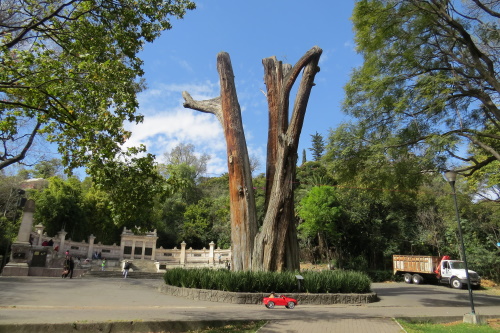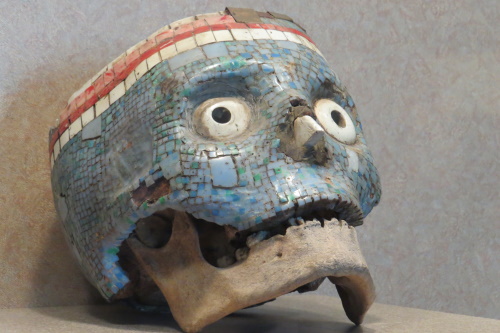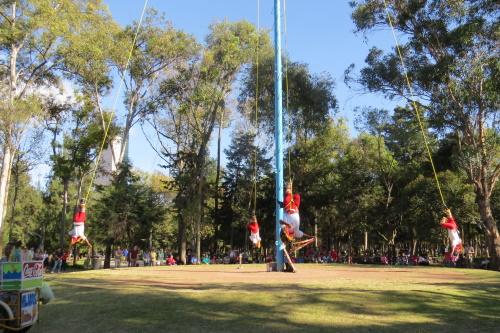Blog TWHS Visits
Chapultepec
Chapultepec Woods, Hill and Castle has featured on Mexico’s Tentative List for almost 20 years now. Most people visiting Mexico City will have been there in some way or another. However, mentioning ‘Chapultepec’ often leads to “mèh” reactions. The 9 voters on this website so far gave it a 22% thumbs up rating, which is pretty awful. Personally I find Mexico City one of the most interesting cities in the world and I’d be happy to go there again. The Chapultepec area also really has some great aspects.
The negative associations may come from the Castle – the 19th century construction is not especially pretty and you need to be a Mexican modern history buff to find it interesting. The Zoo can easily be skipped (although it is famous for its success in giant panda breeding!). The city park itself also is not as lush as those in other capital cities. But there is a lot of history to be found on these 600 hectares. They comprise 3 ‘green lungs’ which are nowadays mostly used for recreational and educational activities by Mexico City's nearly 9 million citizens.
On my second visit to Mexico City in 2014 I explored Chapultepec by bike. I had joined a bicycle tour which I would not especially recommend, but at least we ticked off some of the sights near the Reforma avenue and in the Park. We visited on a Sunday, that’s when the main Reforma road is closed to car traffic. I believe Mexico City was the first city to do so each Sunday, a great initiative I think. Several other Latin American cities have followed its example. We must have encountered hundreds of cyclists and skaters – from beginners to athletes.
In the park we stopped at the Botanical Garden. You can see from the plants here that the climate in Mexico City is very special: it is a city in the tropics, but also at an altitude of 2,400 meters. The vegetation is therefore a mix of tropical plants and plants brought by Europeans. A natural monument of interest deeper into the park is this notable tree: the Ahuehuete "El Sargento". It is a Mexican cypress tree planted by the pre-Columbian ruler Nezahualcoyotl around 1460. It is now reduced to its dead trunk.
After the tour I went to the no.1 highlight of Chapultepec: the Museum of Anthropology. Together with the Gold Museum in Bogota this is right at the top of the best museums across Latin America. Sunday is an extra busy day here, because the Mexicans can enter for free. One can spend hours here, but I stuck to a selection of works from Teotihuacan, Mexica and the coast of Mexico. It was busy, but the museum is so spacious that you can still see the most beautiful things at your leisure.
Finally: the voladores. I had watched them before in 1997 and wanted to relive the experience. The voladores comprise a native Mexican tradition and are part of UNESCO’s intangible cultural heritage list. 5 men climb into a 30 meter high pole and then 4 of them circle around downwards at the same time on a rope tied around one foot. A group of Totonac voladores always performs next to the Anthropological Museum, somewhat hidden behind the hamburger and ice cream stands on a lawn.
I found them with an audience of about 50 people. The men had already climbed to the top of the pole. Some fireworks and music followed, and they started spinning down. Within a few minutes they were back with both feet on the ground. Originally this was a spiritual ceremony, "a fertility dance", but now it is performed for donations.
Els - 7 June 2020
Comments
Arturo Saavedra 7 June 2020
Chapultepec is one of Mexico City's best attractions and a great urban park, but I just don't see it getting WH status anytime soon. For me, it is one of those places in which a lot of its components are moderately interesting but none of them seem to be extraordinarily interesting.
As you pointed out, the Anthropology Museum is a must see for anyone in the city. However, there are other places in the park that may also be of interest to World Heritage travelers. The first one is the Cárcamo de Dolores, which is a hydraulic system of the 1950's, with impressive murals and a fountain, both by Diego Rivera. If you are planning a trip focused on 20th century arts and architecture in Mexico, the Cárcamo deserves a place alongside UNAM, the Barragán house, the Rivera-Kahlo studio and the historic district's murals.
There are also two visitable archeological sites in the park that may appeal to some travelers: A collection of reliefs depicting aztec kings and a water tank built during Moctezuma's rule. None of them are spectaculat but may contribute to a better understanding of Chapultepec's role in Mexico's history.
As for the Voladores, the best way to witness the ritual in its authentic form is to visit the villages of northern Puebla and Veracruz. Cuetzalan is also in Mexico's Tentative List and voladores play a very important role in the community's everyday life. Every Sunday, after the performing the ceremony, the dancers take part in a traditional Nahuatl mass in the parish church.


